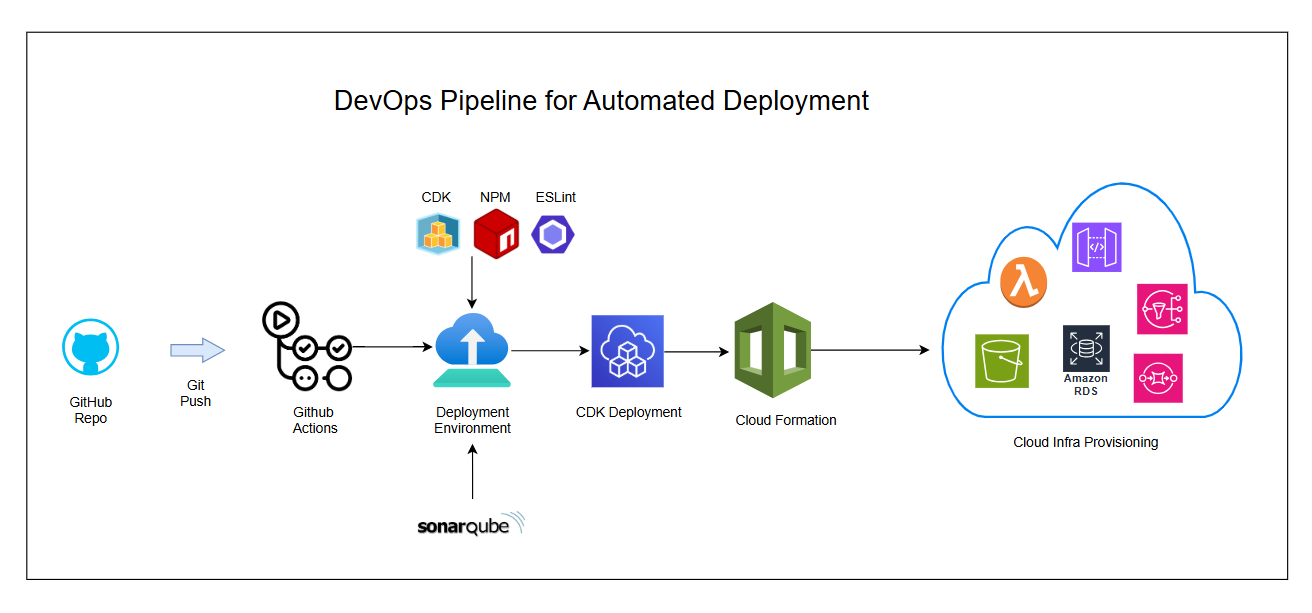
Automate End to End Business Needs with Process Automation
Foundation of Our Approach
Process automation in cloud technology involves using cloud-based technologies to automate repetitive, manual tasks within business processes, streamlining operations by reducing human intervention and allowing for efficient workflows. For businesses to scale, DevOps is an integral component. Without it, the software development team faces slow release cycles, frequent deployment failures, and inconsistent environments, leading to significant delays and frustrated stakeholders. Furthermore, manual interventions and poor coordination with operations create bottlenecks, making troubleshooting a major challenge. As a result, businesses suffer from missed deadlines, reduced agility, and an inability to scale effectively.

Automating DevOps Deployment with GitHub Actions, AWS CDK, and Architecture Flow
- Errors in coding and communication gaps among team members can cause bottlenecks that lead to project delays and increased costs.
- In order to minimize this human error in the DevOps process, it is important to take advantage of various automation tools and techniques that can help streamline tasks and reduce manual intervention.
We aim to showcase how to automate the deployment of an application using GitHub Actions in conjunction with AWS CDK to deploy infrastructure. Herein the goal is to eliminate the need to perform manual deployment steps, thereby reducing any possibility of human error, and ensuring consistency in the deployment process.

The following outlines the key components and processes involved in this initiative.
Detailed Breakdown of the Process
- GitHub Repo: This is our source code repository for the project.
- Git Push: Refers to the action of pushing code changes to the GitHub repository.
- GitHub Actions: A feature within GitHub, beneficial to developers for automating software workflows. It's also used to trigger and orchestrate the pipeline steps.
- Deployment Environment: The environment where the code is build,deployed and tested based on environment configuration i.e. development, staging and production.
- CDK (Cloud Development Kit): A framework for defining and provisioning cloud infrastructure using code.
- CDK Deployment: The process of deploying the infrastructure defined by the CDK code.
- CloudFormation: AWS's infrastructure-as-code service that allows you to model and provision all your AWS resources.
- Cloud Infra Provisioning: The process of creating and configuring the necessary infrastructure resources (e.g., EC2 instances, databases, load balancers) in the cloud.
- SonarQube: An open-source platform for continuous code quality and security analysis.
- NPM (Node Package Manager): A package manager for JavaScript that manages project dependencies.
- ESLint: A static code analysis tool for JavaScript and TypeScript that helps identify and report on patterns in JavaScript code with the goal of making code more consistent and avoiding errors.
How It Works
- Code Changes: A developer makes changes to the code and pushes them to the GitHub repository.
- GitHub Actions Trigger: GitHub Actions is triggered by the code push event.
- Code Analysis: The pipeline runs static code analysis using tools like SonarQube, ESLint, and NPM to check for code quality and security issues.
- CDK Deployment: The CDK code is deployed, which in turn provisions the necessary infrastructure resources using CloudFormation.
- Deployment: The application code is deployed to the target environment.
Business Benefits of this Pipeline
- Automation: Automates the deployment process, reducing manual effort and the risk of human error.
- Continuous Integration and Continuous Delivery (CI/CD): Enables continuous integration and delivery by automating the build, test, and deployment process.
- Improved Quality: Code analysis helps identify and fix issues early in the development cycle, leading to higher code quality.
- Infrastructure as Code: Using CDK and CloudFormation ensures that infrastructure is managed as code, making it easier to version, track changes, and reproduce environments.
- Faster Time to Market: Automating the deployment process allows for faster and more frequent releases of new features and updates.
Automating mundane tasks boosts employee efficiency and empowers your business to scale effortlessly. Connect with our experts to learn how process automation can transform your operations!